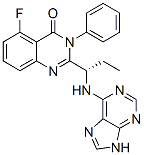
CAL-101 (Idelalisib; GS-1101) is a highly selective and potent p110δ small molecule inhibitor (half-maximal effective concentration [EC(50)] = 8nM). CAL-101 inhibits CLL cell chemotaxis toward CXCL12 and CXCL13 and migration beneath stromal cells (pseudoemperipolesis). CAL-101 (GS-1101) also down-regulates secretion of chemokines in stromal cocultures and after BCR triggering. CAL-101 reduces survival signals derived from the BCR or from nurse-like cells, and inhibits BCR- and chemokine-receptor-induced AKT and MAP kinase (ERK) activation. In stromal cocultures, CAL-101 sensitizes CLL cells toward bendamustine, fludarabine, and dexamethasone. CAL-101 (GS-1101) blocked constitutive phosphatidylinositol-3-kinase signaling, resulting in decreased phosphorylation of Akt and other downstream effectors, an increase in poly(ADP-ribose) polymerase and caspase cleavage and an induction of apoptosis. CAL-101 displays a dual mechanism of action, directly decreasing cell survival while reducing interactions that retain CLL cells in protective tissue microenvironments.
| Cell Experiment | |
|---|---|
| Cell lines | Primary cortical neurons, astrocytes or microglia |
| Preparation method | Assaying TNF secretion For drug treatments, cells were incubated with IC87114 (Symansis), CAL-101 (Active Biochem, #A-1138) and LPS, glucose-free Locke’s buffer (GD), or a combination thereof. For TNF surface delivery assay18, 32, TNF-converting enzyme inhibitor was added at the same time as LPS or included in the glucose-free Locke’s buffer (GD). All inhibitors were reconstituted in dimethylsulphoxide (Sigma) with final concentrations <0.1% in assays. To determine the levels of secreted TNF, a commercial BD OptEIA TNF Elisa Set II (#558534) kit (BD Biosciences) was used to quantify cytokine concentration in samples according to the manufacturer’s instructions. |
| Concentrations | 0,1,5µM |
| Incubation time | 0~10h |
| Animal Experiment | |
|---|---|
| Animal models | wild-type (WT) or p110δD910A/D910A mice |
| Formulation | dimethylsulphoxide (DMSO) |
| Dosages | CAL-101 (40 mg k−1g i.v.) 15 min before ischaemia (CAL-101, Pre) or 3 h after reperfusion (CAL-101, Post) |
| Administration | i.v. |
| Molecular Weight | 415.42 |
| Formula | C22H18FN7O |
| CAS Number | 870281-82-6 |
| Solubility (25°C) | DMSO 59 mg/mL |
| Storage |
Powder -20°C 3 years ; 4°C 2 years In solvent -80°C 6 months ; -20°C 1 month |
| Species | Mouse | Rat | Rabbit | Guinea pig | Hamster | Dog |
| Weight (kg) | 0.02 | 0.15 | 1.8 | 0.4 | 0.08 | 10 |
| Body Surface Area (m2) | 0.007 | 0.025 | 0.15 | 0.05 | 0.02 | 0.5 |
| Km factor | 3 | 6 | 12 | 8 | 5 | 20 |
| Animal A (mg/kg) = Animal B (mg/kg) multiplied by | Animal B Km |
| Animal A Km |
For example, to modify the dose of Compound A used for a mouse (20 mg/kg) to a dose based on the BSA for a rat, multiply 20 mg/kg by the Km factor for a mouse and then divide by the Km factor for a rat. This calculation results in a rat equivalent dose for Compound A of 10 mg/kg.
| Related PI3K Products |
|---|
| SNV4818
SNV4818 is a potential best-in-class (best-in-class) mutation-selective PI3K-α inhibitor with excellent selectivity for the H1047X mutant and moderate selectivity for the related E545/542X mutant. |
| hSMG-1 inhibitor 11j
hSMG-1 inhibitor 11j, a pyrimidine derivative, is a potent and selective inhibitor of hSMG-1, with an IC50 of 0.11 nM. |
| RLY-2608
RLY-2608 is a first-in-class, orally active, selective inhibitor of PI3Ka metabolism. |
| EDI048
EDI048 is an orally active Cryptosporidium PI4K inhibitor for the research of cryptosporidiosis. |
| PI3Kδ-IN-13
PI3Kδ-IN-13 is a PI3Kδ inhibitor (IC50=2.6 nM). |


Products are for research use only. Not for human use. We do not sell to patients.
© Copyright 2010-2023 AbMole BioScience. All Rights Reserved.
